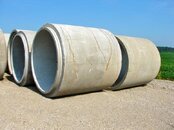We have one very nice facility that we have access to.
It was built for the World Police and Fire Games held in Calgary in 1997. The facilities were set up for the Games during the construction of a man-made “community” lake.
The facilities were used as part of competition for police and fire dive teams. The Community Association that owns the lake and facility allows shops to use that facility for teaching (with a fee).
The facility consists of:
A gravel pad approximately 150 x 50 feet;
17 “navigation” markers imbedded in the bottom. Each marker is concrete, approximately 2 x 2 feet and numbered; and,
8 “structures” made up of up to three concrete culvert sections approximately 6 to 8 feet in diameter. The structures are arranged in various configurations from a single culvert pointing vertical, three in a row laid out horizontally, to three lying horizontal in a “spoke” pattern.
The gravel pad has 7 navigation points on it, which makes it an ideal training area. There can be multiple classes at the site, with plenty of room. Floats can be readily attached to the navigation points as they were formed with attachment points built in.
The structures make great features when you take students on tours. The navigation markers are handy for staff to figure out where they in the lake are and also make for a nice navigation challenge.
You can travel over 1000 feet going from all the navigation points between 1 and 17.
A trip to each of the 8 structures will have you travel approximately 650 feet in total.
Unfortunately the lake is shallow, at most 25 feet. It is what it is.
Away from the gravel pad the lake bottom is silty, so buoyancy control and “good” fining techniques are a must. Some of the structures come within 15 feet of the surface, and so are great for working on controlling buoyancy.
The lake is located in the south part of town, about a 45 minute drive from the shop that I teach through.
It was built for the World Police and Fire Games held in Calgary in 1997. The facilities were set up for the Games during the construction of a man-made “community” lake.
The facilities were used as part of competition for police and fire dive teams. The Community Association that owns the lake and facility allows shops to use that facility for teaching (with a fee).
The facility consists of:
A gravel pad approximately 150 x 50 feet;
17 “navigation” markers imbedded in the bottom. Each marker is concrete, approximately 2 x 2 feet and numbered; and,
8 “structures” made up of up to three concrete culvert sections approximately 6 to 8 feet in diameter. The structures are arranged in various configurations from a single culvert pointing vertical, three in a row laid out horizontally, to three lying horizontal in a “spoke” pattern.
The gravel pad has 7 navigation points on it, which makes it an ideal training area. There can be multiple classes at the site, with plenty of room. Floats can be readily attached to the navigation points as they were formed with attachment points built in.
The structures make great features when you take students on tours. The navigation markers are handy for staff to figure out where they in the lake are and also make for a nice navigation challenge.
You can travel over 1000 feet going from all the navigation points between 1 and 17.
A trip to each of the 8 structures will have you travel approximately 650 feet in total.
Unfortunately the lake is shallow, at most 25 feet. It is what it is.
Away from the gravel pad the lake bottom is silty, so buoyancy control and “good” fining techniques are a must. Some of the structures come within 15 feet of the surface, and so are great for working on controlling buoyancy.
The lake is located in the south part of town, about a 45 minute drive from the shop that I teach through.





